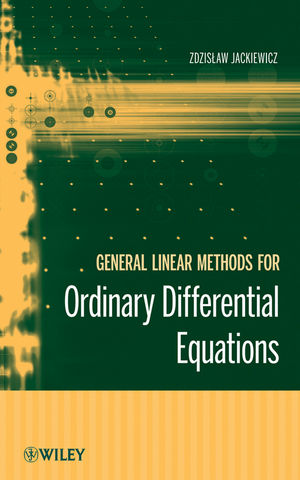General Linear Methods for Ordinary Differential EquationsISBN: 978-0-470-40855-1
Hardcover
504 pages
July 2009
 |
||||||
1 Differential Equations and Systems.
1.1 The initial value problem.
1.2 Examples of differential equations and systems.
1.3 Existence and uniqueness of solutions.
1.4 Continuous dependence on initial values and the right hand side.
1.5 Derivatives with respect to parameters and initial values.
1.6 Stability theory.
1.7 Stiff differential equations and systems.
1.8 Examples of stiff differential equations and systems.
2 Introduction to General Linear Methods.
2.1 Representation of general linear methods.
2.2 Preconsistency, consistency, stage-consistency, and zero-stability.
2.3 Convergence.
2.4 Order and stage order conditions.
2.5 Local discretization error of methods of high stage order.
2.6 Linear stability theory of general linear methods.
2.7 The types of general linear methods.
2.8 Illustrative examples of general linear methods.
2.9 Algebraic stability of general linear methods.
2.10 Underlying one-step method.
2.11 Starting procedures.
2.12 Codes based on general linear methods.
3 Diagonally Implicit Multistage Integration Methods.
3.1 Representation of DIMSIMs.
3.2 Representation formulas for the coefficient matrix B.
3.3 A transformation for the analysis of DIMSIMs.
3.4 Construction of DIMSIMs of type 1.
3.5 Construction of DIMSIMs of type 2.
3.6 Construction of DIMSIMs of type 3.
3.7 Construction of DIMSIMs of type 4.
3.8 Fourier series approach to the construction of DIMSIMs of high order.
3.9 Least-squares minimization.
3.10 Examples of DIMSIMs of type 1 and type 2.
3.11 Nordsieck representation of DIMSIMs.
3.12 Representation formulas for coefficient matrices P and G.
3.13 Examples of DIMSIMs in Nordsieck form.
3.14 Regularity properties of DIMSIMs.
4 Implementation of DIMSIMs.
4.1 Variable step size formulation of DIMSIMs.
4.2 Local error estimation.
4.3 Local error estimation for large step sizes.
4.4 Construction of continuous interpolants.
4.5 Step size and order changing strategy.
4.6 Updating the vector of external approximations.
4.7 Step-control stability of DIMSIMs.
4.8 Simplified Newton iterations for implicit methods.
4.9 Numerical experiments with type 1 DIMSIMs.
4.10 Numerical experiments with type 2 DIMSIMs.
5 Two-Step Runge-Kutta Methods.
5.1 Representation of two-step Runge-Kutta methods.
5.2 Order conditions for TSRK methods.
5.3 Derivation of order conditions up to order six.
5.4 Analysis of TSRK methods with one stage.
5.5 Analysis of TSRK methods with two stages.
5.6 Analysis of TSRK methods with three stages.
5.7 Two-step collocation methods.
5.8 Linear stability analysis of two-step collocation methods.
5.9 Two-step collocation methods with one stage.
5.10 Two-step collocation methods with two stages.
5.11 TSRK methods with quadratic stability functions.
5.12 Construction of TSRK methods with inherent quadratic stability.
5.13 Examples of highly stable quadratic polynomials and TSRK methods.
6 Implementation of TSRK Methods.
6.1 Variable step size formulation of TSRK methods.
6.2 Starting procedures for TSRK methods.
6.3 Error propagation, order conditions, and error constant.
6.4 Computation of approximations to the Nordsieck vector and local error estimation.
6.5 Computation of approximations to the solution and stage values between grid points.
6.6 Construction of TSRK methods with a given error constant and assessment of local error estimation.
6.7 Continuous extensions of TSRK methods.
6.8 Numerical experiments.
6.9 Local error estimation of two-step collocation methods.
6.10 Recent work on two-step collocation methods.
7 General Linear Methods with Inherent Runge-Kutta Stability.
7.1 Representation of methods and order conditions.
7.2 Inherent Runge-Kutta stability.
7.3 Doubly companion matrices.
7.4 Transformations between method arrays.
7.5 Transformations between stability functions.
7.6 Lower triangular matrices and characterization of matrices with zero spectral radius.
7.7 Canonical forms of methods.
7.8 Construction of explicit methods with IRKS and good balance between accuracy and stability.
7.9 Examples of explicit methods with IRKS.
7.10 Construction of A-stable and L-stable methods with IRKS.
7.11 Examples of A-stable and L-stable methods with IRKS.
7.12 Stiffly accurate methods with IRKS.
8 Implementation of GLMs with IRKS.
8.1 Variable step size formulation of GLMs.
8.2 Starting procedures.
8.3 Error propagation for GLMs.
8.4 Estimation of local discretization error and estimation of higher order terms.
8.5 Computing the input vector of external approximations for the next step.
8.6 Zero-stability analysis.
8.7 Testing reliability of error estimation and estimation of higher order terms.
8.8 Unconditional stability on nonuniform meshes.
8.9 Numerical experiments.
8.10 Local error estimation for stiffly accurate methods.
8.11 Some remarks on recent work on GLMs.
References.
Index.



